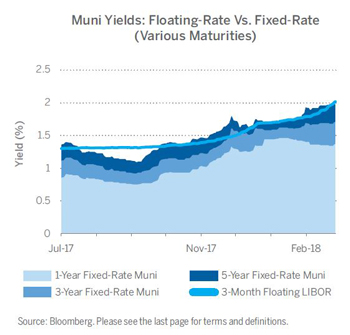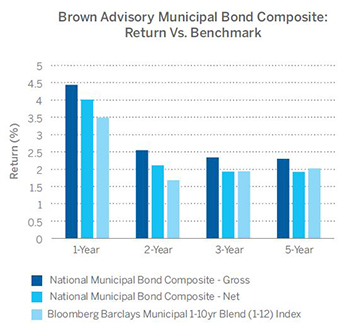We are hearing a lot of questions from our clients about how rising interest rates may affect their municipal bond holdings. We try to remind them that rising rates, despite their inevitable short-term effect on fixed-rate bond prices, do not necessarily mean long-term declines for bond portfolios generally or for municipal bond portfolios specifically. In fact, a municipal bond portfolio can perform quite well through a period of rising rates, thanks to income streams that can help to cushion the impact of price declines and the ability to rotate out of maturing bonds into new holdings with higher yields.
Still, many municipal bond investors are choosing to respond to fears of rising rates by reducing interest rate exposure and broadly shortening portfolio duration. We approach things differently; in general, we do not believe that our strengths lie in forecasting interest rates.
Instead, we focus our research on individual bonds and whether those bonds represent an attractive relative value. In other words, we want to understand whether those bonds trade at an appropriate level based on our view of their potential cash flows. We believe that this process leads to portfolios that offer stability and attractive income generation, both of which are key drivers of long-term outperformance. As we discuss in this article, this approach has directly contributed to our outperformance during the most recent period of rising interest rates dating from the end of 2015.
MUNICIPALS AND RISING RATES
Simple math dictates that when yields rise, fixed-rate bond prices fall. However, there are a few important caveats to that statement.
First, bonds can still produce positive returns when their prices fall. The income component of bond returns can help to buffer the price declines caused by rising rates. Further, bond managers can rotate their holdings as rates rise. As bonds with lower yields mature, managers can reinvest in bonds with higher yields. As bottom-up focused managers, we invest with an intent to hold for the long term, but we may choose to exit bonds that have realized the value we envisioned at purchase and reinvest in bonds that offer a better relative value. The bottom line: Portfolios can produce positive returns throughout a rate-hiking cycle—even if many individual holdings in the portfolio drop in price over shorter time windows.
Second, municipal bonds have particular traits that, in the past, have helped them weather rising rates better than other segments of the fixed income market. The tax-exempt status of municipal bond income has helped to mitigate price erosion when rates rise, as each dollar of interest earned from a municipal bond is worth more to many buyers than a dollar of taxable income.
Finally, there are supply/demand factors that may lend support to municipal bond prices during a period of rising rates. Municipal issuance tends to decline as rates rise because states and cities are less interested in refinancing at higher rates. Also, the new tax law caps state and local income tax deductibility, which should make tax-exempt income sources more valuable to investors in states with high income tax rates. Finally, the tax bill disallowed advance refundings of municipal bonds, a common practice where issuers could lower their costs by refinancing debt at lower rates. Advanced refundings previously accounted for a sizable chunk of new municipal issuance. The overall impact of these factors is not yet clear, but they all represent potential constraints on supply or boosts to demand and could provide support to municipal bond prices going forward.
As we can see in the chart below, municipal bonds generated positive performance during the last several rate hike cycles.
Headwind Resistant
Municipal bonds (as measured by the Bloomberg Barclays U.S. Municipal Index) performed well during recent periods when the Federal Reserve was hiking interest rates.
OUR APPROACH
All of these factors suggest that the municipal market can, in fact, generate attractive returns in a rising-rate environment. What is our approach for realizing that potential?
We pursue returns in the municipal market through a bottom-up process that selects securities for their relative value. To clarify what “bottom-up research” means to us: We spend most of our time thinking about individual issuers and individual bonds. Specifically, we focus on the cash flows we expect to receive from those bonds in expected conditions and the tail-risk scenarios that may prevent us from receiving those cash flows.
In a rising interest rate environment, many bond managers seek to mitigate risk by shortening their portfolio duration. This approach is not without its problems. Shortening duration is still a bet that interest rates will rise; if rates stay flat, the portfolio may forgo opportunity.
Whether rates are rising or falling, we manage risk using the same consistent process: We look for bonds with attractive valuation relative to our view of their potential cash flows.
During the past year or so, our approach has manifested in a few ways in our portfolios. For one, we reduced our exposure to shorter-duration fixed-rate municipals, as their valuations grew increasingly unattractive last year. (We surmise that the bump in short-duration bonds is a direct result of the “duration ratchet” approach used by many muni investors, who feared rising rates and instinctively gravitated to the short end of the yield curve.) At the same time, we sought exposure to floating-rate securities that, in our view, offered better value alongside a reasonable yield.
The logic here was fairly simple: For comparable yield, we would prefer to own a floating-rate instrument with almost no interest rate risk vs. a fixed-rate bond that does carry some interest rate risk. As you can see in the chart below, floating short-term yields compare quite favorably with the yields on one-year, three-year and five-year fixed-rate municipals, and this has been the case for the better part of a year. Our decision to underweight short-duration bonds and seek exposure to floating-rate bonds served to reduce our pure interest rate risk while maintaining income levels. These steps contributed greatly to our relative performance in 2017, particularly in the fourth quarter. Note that this set of decisions had nothing to do with making a duration call and everything to do with relative valuation analysis.
Floating On Cloud Nine
Our National Municipal Bond strategy has outperformed its benchmark by a healthy margin since the end of 2015, when the current cycle of rate hikes began.

Additionally, we have maintained an overweight in credit exposure relative to our benchmark and many of our peers. A specific example is our exposure to A-rated and BBB-rated bonds—at the end of 2017, many portfolios in our National Municipal Bond composite had more than half of their assets invested in this credit range, compared to less than 30% exposure in the composite’s benchmark, the Bloomberg Barclays 1-10yr Blend (1-12) Index.
Our strategies are not “muni credit” strategies. We pursue “core” investment objectives, such as stability and income generation. But we pursue those objectives using a relative value mentality. We have traditionally found a great deal of value in A-rated and BBB-rated municipals, with many issuers demonstrating improved operations and more reliable cash flow streams well before these realities are reflected in their official credit ratings. Our relative emphasis on A and BBB exposure has benefited our returns on balance over time and helped us in 2017.
Resilient with Rates Rising
Our National Municipal Bond strategy has outperformed its benchmark by a healthy margin since the end of 2015, when the current cycle of rate hikes began.

The steps discussed above were all taken within the context of a broader pursuit of stable income generation. Our general approach, and these specific steps, has helped us to outperform our benchmark by a healthy margin since the end of 2015, when the current cycle of rate hikes began (see chart to the right). We are not drawing long-term conclusions from these results; this is simply the time period during which rates have been rising and thus relevant to this discussion. Whether rates are rising or falling, we think that focusing on relative value, rather than duration, will set us apart from many of our peers and offer a path to desirable long-term results. 
Click here to read the National Municipal Bond Composite disclosure
The views expressed are those of the author and Brown Advisory as of the date referenced and are subject to change at any time based on market or other conditions. These views are not intended to be and should not be relied upon as investment advice and are not intended to be a forecast of future events or a guarantee of future results. Past performance is not a guarantee of future performance and you may not get back the amount invested.
The information provided in this material is not intended to be and should not be considered to be a recommendation or suggestion to engage in or refrain from a particular course of action or to make or hold a particular investment or pursue a particular investment strategy, including whether or not to buy, sell, or hold any of the securities or asset classes mentioned. It should not be assumed that investments in such securities or asset classes have been or will be profitable. To the extent specific securities are mentioned, they have been selected by the author on an objective basis to illustrate views expressed in the commentary and do not represent all of the securities purchased, sold or recommended for advisory clients. The information contained herein has been prepared from sources believed reliable but is not guaranteed by us as to its timeliness or accuracy, and is not a complete summary or statement of all available data. This piece is intended solely for our clients and prospective clients, is for informational purposes only, and is not individually tailored for or directed to any particular client or prospective client. Private investments mentioned in this article may only be available for qualified purchasers and accredited investors. All charts, economic and market forecasts presented herein are for illustrative purposes only. Note that this data does not represent any Brown Advisory investment offerings.
The Bloomberg Barclays U.S. Municipal Index is an unmanaged, market value-weighted index which covers the U.S. investment-grade tax-exempt bond market. The Bloomberg Barclays 1-10 Year Municipal Blend (1-12) Index is a market value-weighted index which covers the short and intermediate components of the Bloomberg Barclays U.S. Municipal Index. It tracks tax-exempt municipal General Obligation, Revenue, Insured, and Prerefunded bonds with a minimum $5 million par amount outstanding, issued as part of a transaction of at least $50 million, and with a remaining maturity from 1 up to (but not including) 12 years. Both indexes include reinvestment of income. One can not invest directly in an index. The London Interbank Offered Rate (LIBOR) is the interest rate at which banks offer to lend funds to one another in the interbank market. It often reflects how much it costs for banks to borrow from one another.
Any business or tax discussion contained in this communication is not intended as a thorough, in-depth analysis of specific issues.

